The cause of Buerger’s disease has not been fully diagnosed. Although the cause of some diseases occurring in the world is not known yet, research continues at full speed. However, the cause of a disease that was first described in 1908 is partially known. This disease is called Buerger’s disease. It is known by everyone that smoking causes the emergence of this disease. However, it is not known where and with which substance smoking affects the body. For those who do not know this disease, we will try to explain by examining many titles such as what is Buerger’s Disease, what is its treatment, and what are the symptoms.
- What is Buerger’s Disease?
- Why Buerger’s Disease Occurs?
- What are the Symptoms of Buerger’s Disease?
- What are the Causes of Buerger’s Disease?
- Buerger’s Disease Onset
- Who Gets Buerger’s Disease?
- How is Buerger’s Disease Diagnosed?
- How Is Buerger’s Disease Treated?
- What Section Does Buerger’s Disease Treat?
- Does Buerger Disease Go Away?
- Buerger’s Disease Risk Factors
- Buerger’s Disease Early Symptoms
- How Does Smoking Cause Buerger’s Disease?
- Prices for Buerger’s Disease Treatment in Turkey
- Conclusion
- What is a positive Buerger’s test?
- What is a normal Buerger’s test?
What is Buerger’s Disease?
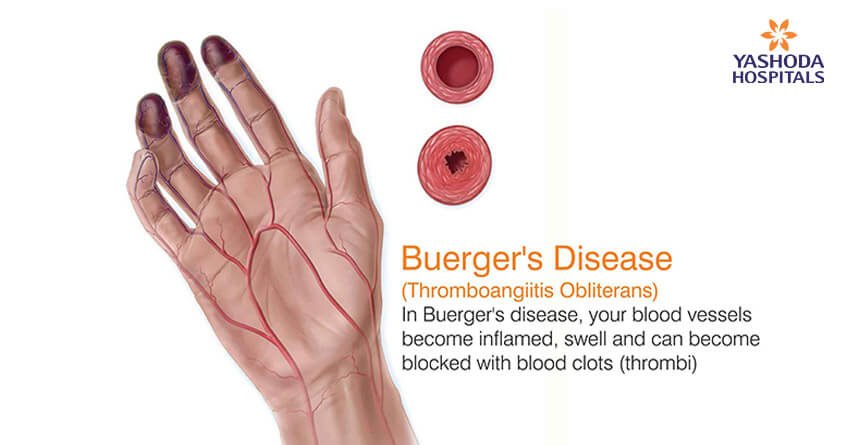
Burger’s disease, which is a disease that usually affects male individuals between the ages of 20-50, causes inflammation in the veins without microbes, due to smoking. After a while, these inflammations begin to cause congestion in the veins, especially in the hands and feet. As a treatment option, smoking cessation is the first condition. However, if smoking is not stopped, advanced treatment methods may be required until limb amputation in the hands and feet.
Even if a clear treatment method has not been found, the first and most important step to be taken for treatment is to quit smoking and tobacco use. The question of what is Buerger’s Disease can be answered briefly in this way.
Why Buerger’s Disease Occurs?
The exact cause of this disease is unknown, but it is strongly linked to tobacco use. Smoking cigarettes, cigars, or chewing tobacco can damage the lining of the blood vessels, making them more susceptible to inflammation and clotting.
Other factors that may increase the risk of Buerger’s disease include:
- Age: This disease typically develops in people between the ages of 20 and 50.
- Sex: Men are more likely to develop this disease than women.
- Genetics: Some people may have a genetic predisposition to this disease.
- Exposure to cold: Exposure to cold temperatures can trigger this disease’s symptoms.
What are the Symptoms of Buerger’s Disease?
- Numbness in hands
- Numbness in feet
- Numbness in fingers
- Coldness in hands
- Cold feet
- Paleness in hands
- Paleness in the feet
- Pain when active, that is, when walking
- In advanced cases, the formation of open sores on the hands and feet
- Gangrene formation
- Pain: Pain in the hands and feet is the most common symptom of Buerger’s disease. The pain may be sharp, dull, or throbbing.
- Numbness: Numbness in the hands and feet is also a common symptom of Buerger’s disease.
- Coldness: The hands and feet may feel cold to the touch, even in warm weather.
- Color changes: The hands and feet may turn pale or blue, especially when exposed to cold temperatures.
- Ulcers: Open sores (ulcers) may develop on the fingers and toes.
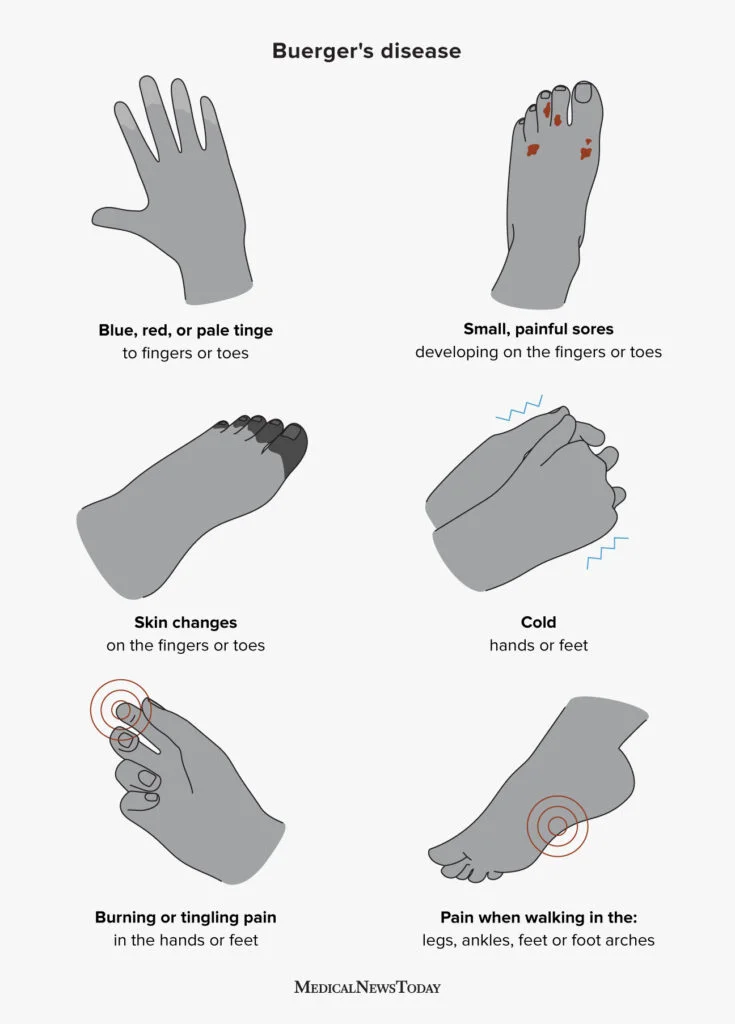
What are the Causes of Buerger’s Disease?
Although the cause seems to be known, the exact cause of Burger’s disease is not known. In other words, it is not known in which region the disease occurs after smoking and tobacco use trigger this disease. When looking at the Causes of Buerger’s Disease, the most important known and main cause is tobacco use. Factors such as exposure to cold, age, and gender can also trigger this disease.
Buerger’s Disease Onset
The onset of Buerger’s Disease usually begins with nail clipping to care for hands and feet. Wounds that occur after nail clipping do not heal and begin to grow over time. If it is not diagnosed and treated, or if it is diagnosed late and treatment is started, it can lead to worse results. Especially if the smoking cessation process, which is the first step of treatment, is not performed, limb loss may occur.
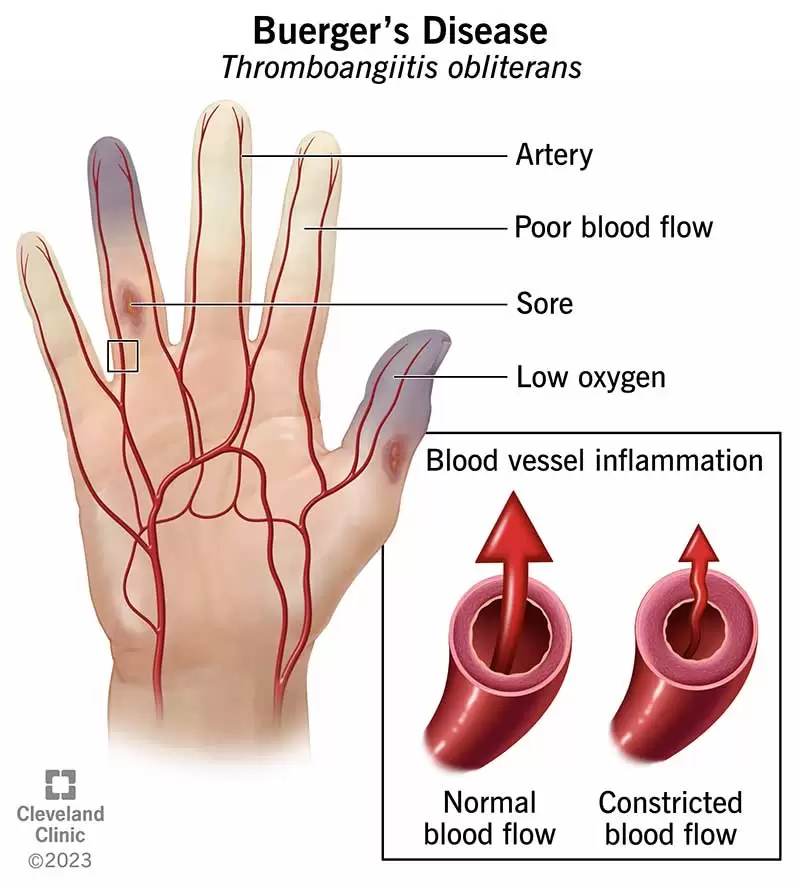
Who Gets Buerger’s Disease?
- Often between the age group of 20 and 50
- In smokers
- mostly in men
- In people who are frequently exposed to cold
- In people living at a low socioeconomic level
- People with bad eating habits
- In people who have had hepatitis B or jaundice
- In people with high fibrinogen
How is Buerger’s Disease Diagnosed?
When the question of How to Diagnose Buerger’s Disease is asked, we see that there is no clear diagnostic method used in the diagnosis of this disease. In other words, some routine examinations, tests, and examinations are performed for people who go to a doctor’s control after some symptoms and complaints. Generally, imaging methods and blood tests are used. Pale color and coldness in the limbs are also important details in terms of diagnosis.
To diagnose Buerger’s disease, a doctor will perform a physical exam and review the patient’s medical history. The doctor may also order blood tests and imaging tests, such as an angiogram or MRI, to assess the blood vessels of the hands and feet.
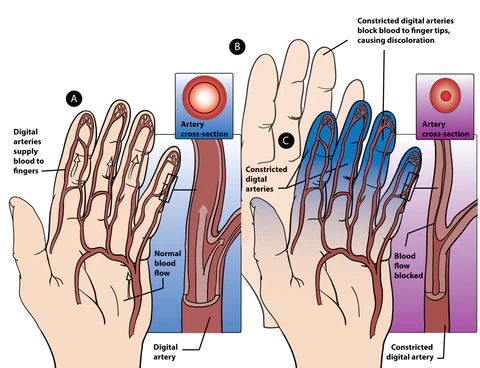
How Is Buerger’s Disease Treated?
Although there is no clear cure, the first step in the treatment process is to quit smoking and tobacco use completely and to stay away from smoking environments as much as possible. It is aimed to restore blood flow in the area with the drugs prescribed by the doctor. In some cases, the progression of the disease is stopped with bypass. In addition, it was observed that the limbs with gangrene were amputated in advanced cases. How to Treat Buerger’s Disease can be briefly explained in this way.
What Section Does Buerger’s Disease Treat?
When we wonder which department deals with Buerger’s Disease, we see that cardiovascular doctors are interested in this disease. If you suspect Buerger’s disease and experience some symptoms, you should go to the cardiovascular diseases department of hospitals and be examined.
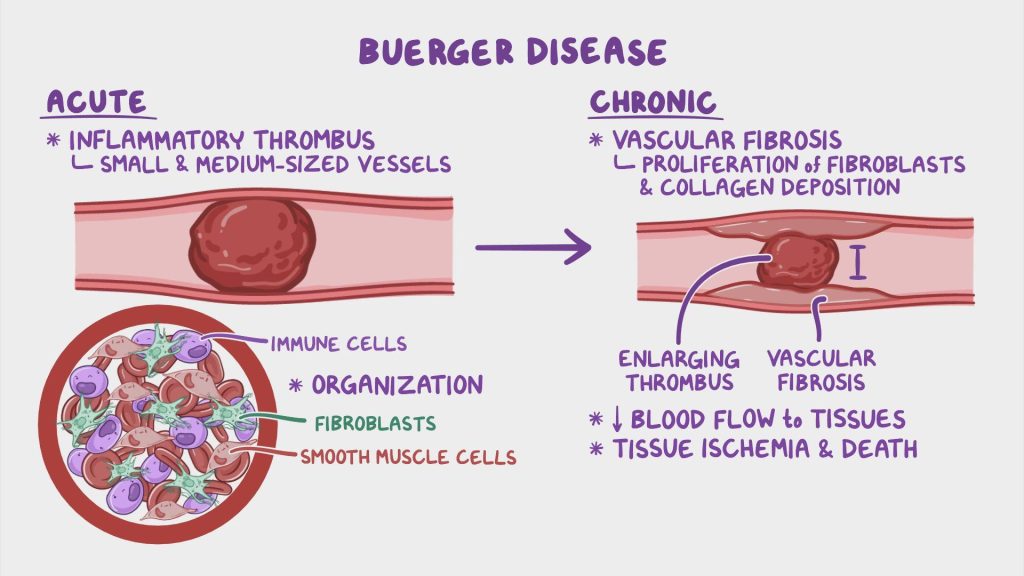
Does Buerger Disease Go Away?
Buerger’s disease, also known as thromboangiitis obliterans, is a rare condition that affects the blood vessels in the limbs, particularly in the arms and legs. It is characterized by inflammation and clotting, causing restricted blood flow and tissue damage.
One common question among individuals diagnosed with Buerger’s disease is whether it goes away on its own. Unfortunately, there is no definitive answer to this question. Buerger’s disease is a chronic condition, meaning it tends to persist over time. However, the progression of the disease can be halted or slowed down by adopting certain lifestyle changes.
The most crucial step in managing Buerger’s disease is to quit smoking. Smoking is the primary risk factor for developing the disease and can exacerbate its symptoms. Additionally, maintaining a healthy lifestyle by eating a balanced diet, exercising regularly, and managing stress can also help improve blood circulation and reduce symptoms.
While there is no known cure for Buerger’s disease, early diagnosis and proper management can significantly improve the quality of life for those affected. Regular check-ups with a healthcare professional and following their recommended treatment plan are essential for managing the disease effectively.
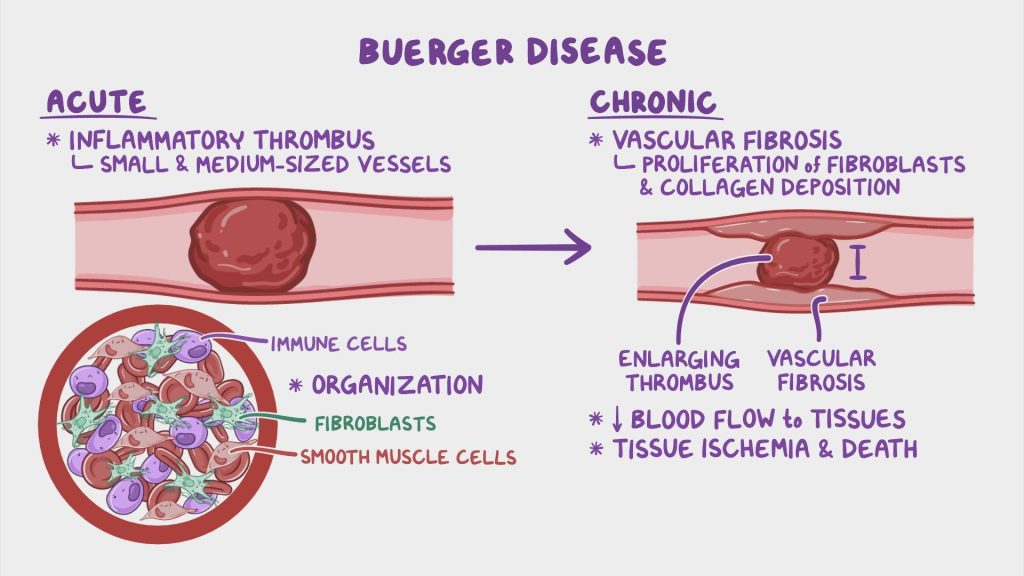
Buerger’s Disease Risk Factors
Buerger’s disease, also known as thromboangiitis obliterans, is a rare inflammatory condition that causes blood vessels in the hands and feet to become narrow or blocked. This can reduce blood flow to the affected areas, leading to pain, numbness, and other symptoms.
Smoking
The biggest risk factor for Buerger’s disease is smoking. In fact, more than 90% of people with Buerger’s disease smoke or chew tobacco. Smoking damages the blood vessels and makes them more likely to become inflamed and blocked.
Other risk factors
Other risk factors for Buerger’s disease include:
- Sex: Men are more likely to develop Buerger’s disease than women.
- Age: Buerger’s disease typically develops in people between the ages of 20 and 45.
- Genetics: Some people may be more genetically susceptible to Buerger’s disease.
- Cold weather: Cold weather can trigger symptoms of Buerger’s disease.
- Raynaud’s phenomenon: Raynaud’s phenomenon is a condition that causes the blood vessels in the fingers and toes to spasm in response to cold or stress. People with Raynaud’s phenomenon are at increased risk of developing Buerger’s disease.
How to reduce your risk of Buerger’s disease
The best way to reduce your risk of Buerger’s disease is to quit smoking. Smoking cessation can help to improve blood flow and reduce inflammation. Other things you can do to reduce your risk include:
- Avoiding cold weather
- Managing stress
- Wearing warm clothing and mittens or gloves in cold weather
- Exercising regularly
- Eating a healthy diet
If you have any of the risk factors for Buerger’s disease, it is important to see your doctor regularly for checkups. Early diagnosis and treatment can help to prevent serious complications of the disease.

Buerger’s Disease Early Symptoms
Buerger’s disease, also known as thromboangiitis obliterans, is a rare inflammatory condition that causes blood vessels in the hands and feet to become narrow or blocked. This can reduce blood flow to the affected areas, leading to pain, numbness, and other symptoms.
Early symptoms of Buerger’s disease
The early symptoms of Buerger’s disease can be subtle and may be mistaken for other conditions. Some of the most common early symptoms include:
- Raynaud’s phenomenon: Raynaud’s phenomenon is a condition that causes the blood vessels in the fingers and toes to spasm in response to cold or stress. This can cause the fingers and toes to turn white, blue, and then red.
- Pain in the fingers and toes: Pain in the fingers and toes is another common early symptom of Buerger’s disease. The pain may be sharp, burning, or throbbing. It may be worse when walking or exercising.
- Numbness and tingling in the fingers and toes: Numbness and tingling in the fingers and toes can also be early symptoms of Buerger’s disease. This is caused by the reduced blood flow to the affected areas.
- Coldness in the fingers and toes: Coldness in the fingers and toes is another common early symptom of Buerger’s disease. This is caused by the reduced blood flow to the affected areas.
- Color changes in the fingers and toes: The fingers and toes may turn red, blue, or white in response to cold or stress. This is caused by the blood vessels in the fingers and toes spasm.
Other early symptoms of Buerger’s disease may include:
- Leg cramps
- Hair loss on the legs and feet
- Slow-healing sores on the fingers and toes
If you experience any of these early symptoms of Buerger’s disease, it is important to see your doctor right away. Early diagnosis and treatment can help to prevent serious complications of the disease.
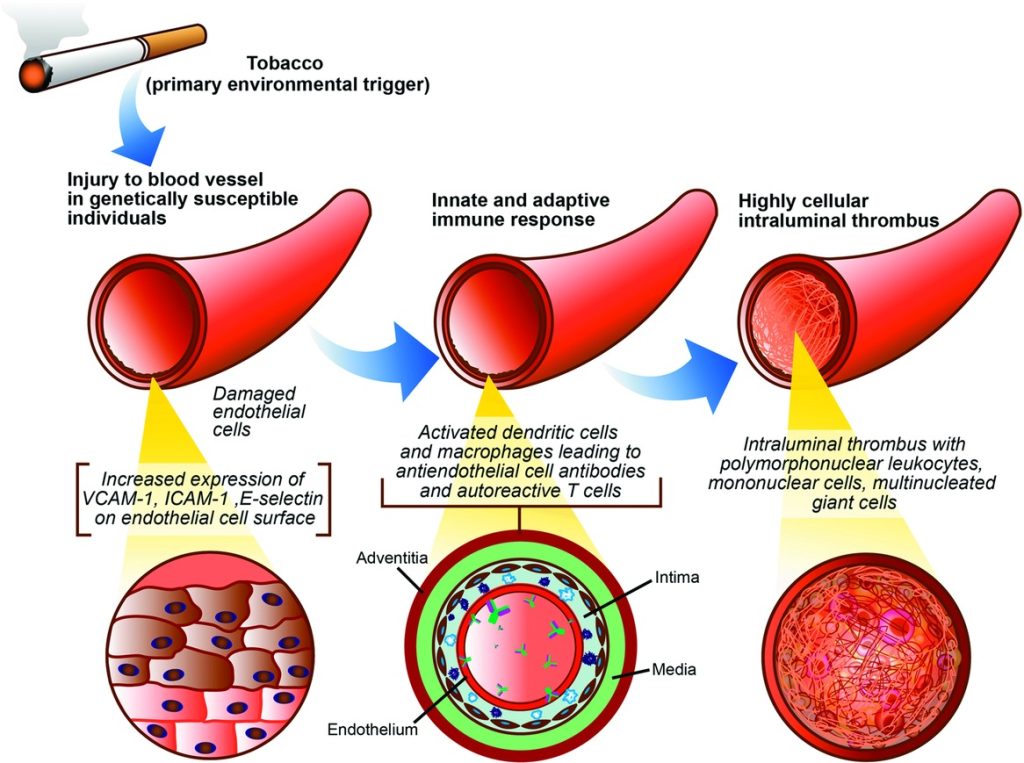
How Does Smoking Cause Buerger’s Disease?
Buerger’s disease, also known as thromboangiitis obliterans, is a rare and severe condition that affects the blood vessels in the arms and legs. While the exact cause of this disease is still unknown, it has been strongly linked to smoking.
Smoking tobacco is known to damage blood vessels and decrease blood flow throughout the body. The chemicals present in cigarettes cause inflammation and thickening of blood vessel walls, leading to the formation of blood clots. These blood clots can block the vessels, restricting blood flow to the extremities, which can result in tissue damage and severe pain.
Furthermore, smoking also weakens the immune system, making it harder for the body to fight off infections. In Buerger’s disease, the weakened immune response allows the blood vessels to become inflamed and narrow, leading to the formation of blood clots.
It is important to note that Buerger’s disease only affects individuals who smoke or use other forms of tobacco, such as chewing tobacco or snuff. Quitting smoking is the most effective way to prevent and manage this debilitating disease. If you or someone you know is struggling with tobacco addiction, seek professional help to quit smoking and reduce the risk of developing Buerger’s disease.
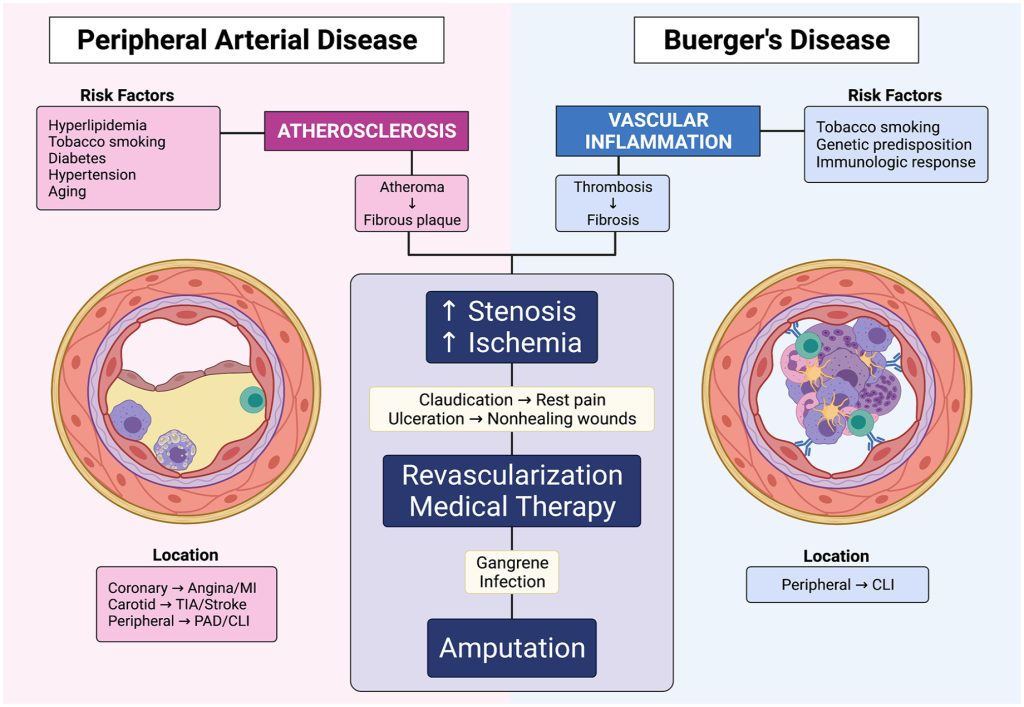
Prices for Buerger’s Disease Treatment in Turkey
Turkey carries out the treatment of many diseases, large and small, with a high success rate. We can see that foreign citizens, in particular, have diseases that they cannot find a cure for in their own country, have them treated in Turkey, and return to their countries in a healthy way. Conditions such as the fact that the treatment process is highly positive and that there is no problem in entering the country and traveling are shown among the reasons for preference. We can list other reasons for preference as follows:
- Due to its geographical location, it is easy to reach from every country
- Easier visa procedures with the invitation letter sent by us
- Hospitals are large and fully equipped
- Scientific diagnosis and treatment methods
- Doctors are experts in their fields
- Nurses are experts in their fields
- All health personnel, including the intermediary company that deals with patients, are friendly and helpful
- Opportunities such as diagnosis, treatment, accommodation, eating, drinking, and vacation are met at affordable prices
Before coming to our country, we know that foreign citizens do research on Buerger’s Disease Treatment Prices in Turkey. However, it would not be correct to give clear price information at this stage. Because every disease is individual. Many factors such as diagnosis and treatment methods and duration of treatment directly affect the prices. You can contact us by calling us for detailed information about the price. In addition, if you come to Turkey for Buerger’s Disease Treatment through us, we can facilitate your visa procedures with the invitation letter sent by us to the consulate.
Conclusion
As a result, if we need to summarize, Burger’s disease, which occurs as a result of vascular occlusion, especially in smokers, can cause limb loss. The most important step to be taken in the treatment phase will be to quit smoking and stay away from smoking environments. This disease, which has many symptoms, is usually caused by smoking in men and between the ages of 20-50. For treatment, it is necessary to apply to the cardiovascular diseases department.
In the treatment process, our aim is to bring the patient and the doctor together and send our guests to their homes in a healthy way after the diagnosis and treatment process proceeds smoothly and ends. You can contact us for detailed information.
What is a positive Buerger’s test?
A positive Buerger’s test is a clinical test that indicates that a person has reduced blood flow to their legs. The test is performed by having the patient lie down and elevate both legs to an angle of 45 degrees for one to two minutes. The examiner then observes the color of the patient’s feet. If the feet become pale, it indicates that the blood flow to the legs is reduced.
A positive Buerger’s test is not specific for Buerger’s disease, but it can suggest that the patient has some type of peripheral artery disease (PAD). PAD is a condition in which the arteries in the legs become narrowed or blocked, reducing blood flow to the legs.
Other causes of a positive Buerger’s test include:
Atherosclerosis
Diabetes
High blood pressure
High cholesterol
Smoking
Raynaud’s phenomenon
Lupus
Scleroderma
What is a normal Buerger’s test?
A normal Buerger’s test is one in which the feet remain pink even after being elevated to an angle of 45 degrees for one to two minutes. This indicates that the blood flow to the legs is adequate.
If the feet become pale during the test, it is known as a positive Buerger’s test. This can suggest that the patient has reduced blood flow to their legs, which can be caused by a variety of factors, including Buerger’s disease, peripheral artery disease (PAD), atherosclerosis, diabetes, high blood pressure, high cholesterol, smoking, Raynaud’s phenomenon, lupus, and scleroderma.

Vimfay International Health Services
Cervical Sympathectomy surgery Please send information about the price